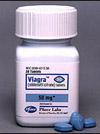 |
||||||||||
|
In our efforts to provide you with the most comprehensive site possible, we have included various articles relating to Viagra®. |
||||||||||
|
Mestel, Rosie Sexual Chemistry.(discovery of viagra)(Brief Article) Discover v20, n1 (Jan, 1999):32 (1 pages). COPYRIGHT 1999 Walt Disney Company IT WAS INCREDIBLE, absolutely incredible," recalls Peter Ellis. And Ellis hadn't even sampled Viagra. His thrill, and that of his Pfizer co-workers, was one of discovery. An experiment had just concluded. Twelve men had swallowed "compound UK-92,480" three times daily for a week, then watched bemusedly as attendants fitted their penises with the RigiScan, a device with two rings to measure the penis at its base and tip. The men sat back, the adult videos rolled, the RigiScans did their work--and so, it turned out, did the penises. All but two hardened. Thrilling indeed, because all 12 men were impotent. Within a few months the scientists learned that you didn't need to pop compound UK-92,480--or sildenafil--for days on end to get the desired effect: one hour before intercourse usually did the trick. Government approval followed in March--along with a jump in Pfizer stock and 4 million prescriptions filled in just six months. The Pfizer folks hadn't set out to create an anti-impotence drug. Chemist Nick Terrett and colleagues were after a drug that would treat heart disease. It needed to do two things: prevent blood clots, by hampering the action of platelets, and enhance blood flow, by relaxing the walls of arteries and veins. Sildenafil did that nicely in the lab but didn't work so well in the bodies of real live people. Still, the drug was having an effect: some men who were given sildenafil reported having erections, which meant the drug was meddling with a particular bit of body chemistry. When males become aroused, nerves in the penis release nitric oxide. The nitric oxide activates an enzyme--called cyclic GMP--that triggers walls of blood vessels in the penis to relax. When they do so, blood rushes in and causes stiffness. The more of this enzyme, the better the rush. Ordinarily, cyclic GMP is broken down rather quickly; sildenafil achieves its effect by causing the enzyme to stick around longer, and it does this chiefly by reining in one of ten or so other enzymes whose function is to degrade cyclic GMP. What the Pfizer researchers now had to show was that this particular degrading enzyme was present in abundance in the penis. Deft biochemical analysis of a frozen penis, ordered from a tissue bank, soon showed that it was. The next step required fresh penile tissue, not frozen. Pfizer researchers obtained such tissue (discarded during penile implant surgeries) and placed thin strips of it in a fluid-filled dish. When they then stimulated the tissue's nerves electrically, they discovered that it relaxed much more--the desired state in erections--if sildenafil was added to the fluid. As millions of men now know, Viagra works. But not for everybody--its success rate is 70 percent. And Viagra has side effects. It can hamper an enzyme crucial to vision. That explains the strange, transient symptoms that some men report, especially those on higher doses: heightened sensitivity to light and a blue-tinged world. Arteries and veins elsewhere in the body, meanwhile, are chock-full of the same enzyme Viagra grabs onto in the penis. If those blood vessels relax too much, the result can be flushing and sharp drops in blood pressure. Add drug-delivered nitrates that are prescribed for heart disease--and which the body breaks down into nitric oxide--and those vessels can dilate to such an extent that strokes or heart attacks may occur. (Heart specialists--and the Viagra package insert--warn against mixing the drugs.) By the end of July, 69 deaths had been reported among men on Viagra; 12 involved men taking nitrates. Still, for the most part, Viagra is seen as a wonderful drug. "For some people it's truly a wonder drug," comments James Barada, who runs the Center for Male Sexual Health in Albany, New York. And perhaps for more of us as well. The clitoris is physiologically very similar to the penis, and some women have problems with sexual arousal. All in their heads? Maybe not. The clinical trials are rolling, and the results should be announced sometime in 1999. ROSIE MESTEL ("Sexual Chemistry," page 32) is a U.S. correspondent for the British magazine New Scientist and a contributing editor of Health. |
||||||||||